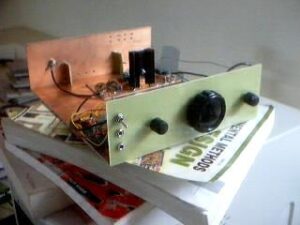Ashar Farhan won the first concession in 1982. On this more than 40-year journey of the radio amateur world, there are milestones such as Bitx, UBITX and SBITX. Although any of these TCVR-You don't have on the table, you may have heard of them.
Bitx TCVR

Bitx is a KV TCVR-A kit, characterized by a simple concept using Bi-Direct amplifiers. This allows you to create a simple but functional SSB TCVR to one or several adjacent bands. There is a complete TCVR on one surface joint, the price of which is approx. $ 50. Since the first version of 2003, several versions have been created and each has found a circle of supporters.
UBITX TCVR
UBITX is a kit CW/SSB TCVR-A to most kV bands (3 to 30 MHz, but works experimentally after 432 MHz). The term kit is no longer quite accurate because the radio amateur just needs to connect the installed flat connections and implement the mechanical construction.
Again, several versions were created and a number of modifications thanks to the openness of the code. The price of UBITX ranged from $ 109.
SBITX TCVR
Progress you will not stop, and vu2ese comes with a new TCVR, hybrid SDR with a power of 40W (at 80m and 40m) and built -in support for digital fashion as PSK31., ' RTY or FT8. Again in a favorable price of $ 299 (without Raspberry Pi, display and microphone). The principle that everyone can modify the code.
The aim of SBITX is TCVR, which does not have to be expensive and has excellent features. SBITX is based on ordinary 2N2222 and Raspberry PI transistors. The attentive reader has already registered that this is a hybrid SDR TCVR. This is otherwise the concept that the Yaesu FTDX-10 has.
This is a combination of a classic analog filter as a Superhet and SDR receiver. In order to maintain a favorable price and excellent parameters, Ashar had to reach the filter at 40 MHz. The tax for that is SDR width 25 kHz. The view of the spectrum is not large. However IIIP3 has a value of +28 dBm and suppression of the unwanted band -70 dB.
The income is in the range of 100 kHz to 30 MHz, broadcasting 3500-4000, 7000-7300,10000-10150, 14000-14350, 18000-18200, 21000-21450, 24800-25000, 28000-29700 (KHz). Fashion: USB, LSB, CW, CW-Reverse, RTTY (45), PSK31, FT8 (including income and broadcasting directly from SBITX) and two-tone measurement signal for measurement IMD and pep. Consumption for income up to 1.5A, for broadcasting 10A.
The receiver has AGC, which was a feature that was missing the previous VU2ese TCVR. By TCVR-I is integrated raspberry pi, so Also included is a diary with TX macros, recording connections in WAV format or connection to RBN and DX Clustre directly from SBITX.
The SBITX end level uses cheap transistors IRFZ24N. The full power of 40W reaches SBitx in the bands 80m and 40m, at 30m and 20m it is 30W, at 17m and 15m 20W. Even less, 10W is at 12m and 6W to 10m. Why? The amplifier chain in the transmitter starts with -15 dBM and ends with +46dbm. The profit of the amplifiers is dependent on frequency and therefore many designers avoid multi -band devices.
Part of the transmitter is also Speech processor.
SBITX is still in development. Radio amateurs are helping to improve the TCVR by detecting shortcomings. So it is not yet possible to talk about the finished device, but it is likely that SBITX, like the other TCVR-E VU2ese, will find supporters. More on https://www.hfsignals.com/index.php/sbitx/

At this point, the up to date is the SBITX V2. https://youtu.be/voxpnnzh3kc?si=QJT_R18SayGxqyjw